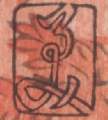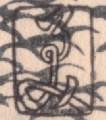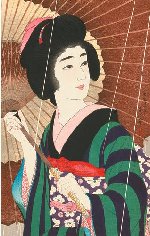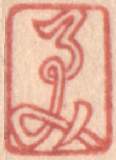These pages contain odd bits of Shin Hanga information that haven't yet found their contextual home in the Articles section or elsewhere. (Send yours in!)
|
Medium Rare 21 February 2002 Before the Great Fire and Earthquake of September 1923, Watanabe had published three full "travel series" of Hasui prints. Were they all lost, as widely reported? Here's how many Hasui prints were exhibited at the 1930 Toledo exhibition, understood to be supplied from Watanabe's inventory except as noted.
Super-rare? The catalog states: "Some of the prints are no longer available, as the editions as a rule are small, but many are available and may be purchased." Possibly the real loss to Watanabe's stock of prints, was in the next series Selection of Scenes of Japan (started 1922). About 30 of these prints were issued before the earthquake; none of these were exhibited at Toledo. The 6 post-earthquake prints in this series were all shown, as was virtually every print in the next five series thereafter (in 1930 and 1936).
Which was the first Hasui print issued after the earthquake?
| |
|
Yoshida Ephemera 22 October 2002 Hmm.... what to get the Yoshida collector who has everything? This item was found in an old bookseller catalog:
There are several online references to it, one is summarized below. Happy hunting! Illustrated by Hiroshi Yoshida
Tokyo: Japan Advertiser, 1928. Hard Cover. 1st Edition. Elephant Folio - over 15" - 23" tall. Very nice copy in both dust jacket and hardcover folder. This is "a complete account of the Enthronement Ceremonies from December 25, 1926 to December 13, 1928, together with special articles interpreting those ceremonies, and greetings to His Imperial Majesty the Emperor and the Japanese people from foreign sources." Deep purple cloth covers with bold and colorful image of bird on the front cover; gilt floral decoration on back cover. Original color woodblock print of "Himeji Castle" by Hiroshi Yoshida. All paper edges gilt. The covers are held together by two multi-colored silk ties at hinge. The book is protected with a grey cloth-covered hardcover folder with paper label. Two bone clasps secure the folder around the book. A wonderful and scarce document.
| |
|
The Delimited 23 October 2002 Collectors know to be skeptical about Japanese "limited" edition notations on shin hanga prints. Western notions do not always prevail. But here's an example, slightly less inscrutable than usual, where a clue is laid more openly: Entitled Ame (Rain), signed Kotondo ga with artist's seal Kotondo, dated Showa 4.10 (October 1929), title embossed in lower margin, embossed seal of publishers Sakai and Kawaguchi to lower left margin, edition notation Gaikoku yuki nihyaku mai kagiri zeppan dai juyon go (No. 14 of limited edition of 200 for export abroad) to verso, very good impression and color, slight horizontal creasing at lower right and left margins, paper tape to reverse edges, otherwise good condition. 46.5 x 29 cm
Estimate $2500 / $3500
| |
|
Bi no Rumi 24 November 2002


But we now introduce another view:
| |
|
See Korea 25 December 2002
A: N435 to N442 are the complete series "Eight Views of Korea", as listed in Merritt & Yamada. These were first produced in 1939 by a Kyoto or Osaka publisher called Kansai Bijutsusha (not to be confused with the Bijutsusha mentioned above). This is the cartouche seal in the right margin; the original prints also bear the rectangular Hasui stamp unique to this series. These blocks were later acquired by Watanabe. Prints were reissued with standard Watanabe seals and sometimes with the familiar round Hasui stamp. Also acquired was the 1940 follow-on series "Korean Views, Supplement", N443 to N448, the first five of which appear in Narazaki with Watanabe "C" seals.
|
|
|
|







